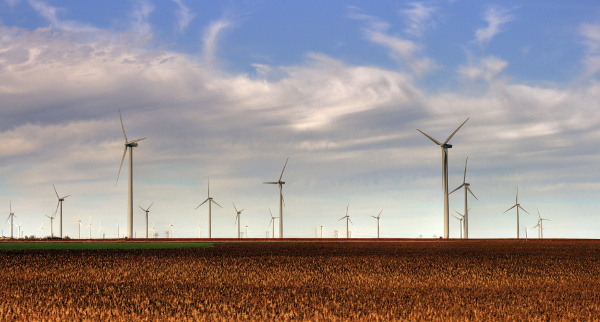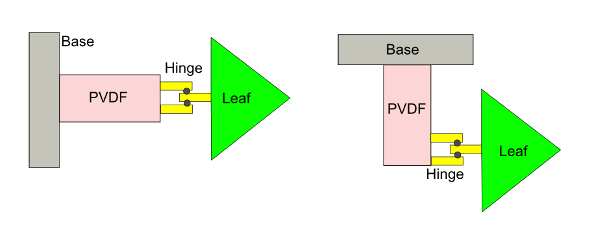| Tikalon Blog is now in archive mode.
An easily printed and saved version of this article, and a link
to a directory of all articles, can be found below: |
|
This article |
| Directory of all articles |
Flutter Power
August 17, 2010
One memory I have from my youth is the family laundry flapping in the wind on the clothesline.
Upstate New York, where I spent my childhood, is a very windy area, and quite a few
wind farms are being sited there, much to the consternation of the local residents.[1] These wind farms use the current wind-harvesting technology; namely, huge
turbine-generators mounted on tall towers. Engineers at
Cornell University have been developing a new type of wind energy-harvesting that has much in common with clothing flapping on a clothesline.

Wind farm in Kansas (Photo by Elekhh).
Air is a
fluid, and wind is a flowing fluid, so there's a commonality between methods of harvesting energy from flowing water and the wind. Turbines, of course, are used in each case, but there's another method. A decade ago, researchers invented the energy-harvesting eel, a flexible tube that oscillates in flowing water.
Piezoelectric transducers of
Polyvinylidene fluoride (PVDF) change this mechanical motion into electrical current.[2-3] The Cornell University approach uses PVDF, also, but their wind harvester resembles tree leaves.[4-6] Although this harvester is not that efficient, its appearance is less objectionable than that of a wind turbine, so it's more suitable for urban areas.
One simple such device, much like the energy-harvesting eel mentioned above, has a flexible
airfoil attached to a piezoelectric pole. Air flow causes the pole to vibrate, generating electricity. Note that piezoelectrics generate their electrical currents through multiple bending and release actions, such as vibration. Bending a piezoelectric will generate an electrical pulse, but holding it steady in that bent state generates no further energy. There must be continual movement to obtain energy. Wind tunnel tests showed that a 13 centimeter long device in a two meter-per-second airflow will generate a few milliwatts. Running many of these in parallel (a "tree") lets you sum these milliwatts into watts of power. Another approach, as shown in the figure,[6] uses a flapping motion as found in actual tree leaves. The power output for this approach is less, but the piezoelectric leaves are smaller and easier to make. The following figure shows two configurations of the energy-harvesting architecture, and the table shows the measured performance of microwatts of power for particular airflow conditions.

Horizontal and vertical arrangements of the piezoelectric wind energy-harvester.[6]
| Orientation | Configuration | μW | m/sec |
| Horizontal | Long single-layer PVDF stalk | 17 | 6.5 |
| Vertical | Short single-layer PVDF stalk | 296 | 8.0 |
| Vertical | Long single-layer PVDF stalk | 76 | 3.5 |
| Vertical | Long air-spaced double-layer PVDF stalk | 119 | 6.5 |
Another Cornell team is designing structures that focus the airflow onto the active portions of the devices, generating a little more power per leaf. They estimate that such wind-harvesting systems could attain about five watts per square meter of cross-section. Since a hair dryer requires about a thousand watts of power, you would need an area about the side of a barn to dry your hair.[7] Not only that, the wind must be blowing, so it would be better to just stand outside for a while and let the wind dry your hair.
References:
- Jennifer Bogdan, "Litchfield council extends moratorium on wind projects," Utica Observer-Dispatch, Aug 11, 2010.
- G.W. Taylor, J.R. Burns, S.M. Kamman, W.B. Powers, and T.R. Welsh,"The Energy Harvesting Eel: A
Small Subsurface Ocean/River Power Generator," IEEE Journal of Oceanic Engineering, vol. 26, no. 4 (2001), pp. 539-547.
- J.J. Allen and A.J. Smits, "Energy Harvesting Eel," Journal of Fluids and Structures, vol. 15 (2001), pp.629-640.
- Duncan Graham-Rowe, "Innovation: Reinventing urban wind power," New Scientist Online, August 6, 2010).
- Matthew Bryant and Ephrahim Garcia, "Development of an Aeroelastic Vibration Power Harvester," Proc. SPIE, vol. 7288, no. 728812 (April 6, 2009).
- Shuguang Li and Hod Lipson, "Vertical-Stalk Flapping-Leaf Generator for Wind Energy Harvesting," Paper SMASIS2009-1276 of the Proceedings of the ASME 2009 Conference on Smart Materials, Adaptive Structures and Intelligent Systems (Oxnard, California), September 20-24, 2009.
- That's an actual farm barn. Physicists, who are always playful characters, have adopted the Barn as a unit of cross-sectional area. A Barn is equal to 10-28 m2, which is roughly the cross sectional area of a uranium nucleus.
Permanent Link to this article
Linked Keywords: Upstate New York; wind farms; turbine-generators; Cornell University; Smoky Hills Wind farm, Kansas; fluid; Piezoelectric; Polyvinylidene fluoride; airfoil.